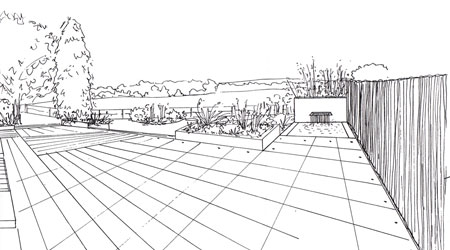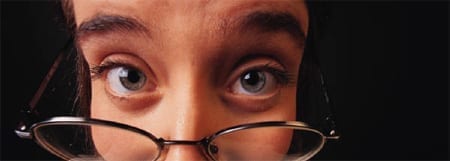
I was discussing garden design with Alison Kerr from Loving Nature’s Garden the other day, specifically about how tough it can be to visualise how the garden design changes you want to make will look.
The sentence “I just can’t visualise” has been muttered into my little ears more times than I care to remember from my garden design clients. But Alison’s remark got me thinking….
How do you visualise a finished garden design?
Whilst creating the beginner’s Garden Design Course I have had to think back a lot in the past months about what problems I encountered when I first started to design gardens and how I got past those problems. One thing I hadn’t really thought about, though, was visualisation…
Now that I have taken the time to stop and think about it, something quite shocking occurred to me. I couldn’t visualise at ALL when I first started. More shocking than that, I’ve only really started to be able to ‘see’ how something will look in the last 5 or 6 years!
So how on earth did I manage to be a successful, professional, garden designer if I couldn’t visualise for the life of me?
That is an excellent question – one I was very surprised to be asking myself! When I think back, it all comes down to the way I was taught at college. We started and finished the whole design process on paper.
Looking at your garden design on a plan will help you see what works and what doesn’t without the need to visualise.
To explain that further – garden design is about shape, proportion and movement through the garden. It’s much easier to see that from above (the plan view) than it is whilst you are standing in the garden.
One of the most important things I learnt is – if a landscape design works on paper it will work in the garden. Because I was working mostly with shapes to get the key design principles working and because I understood how the design principles worked, I didn’t need to visualise.
I do remember when my first few garden design plans were built, how anxious I felt during the process. They were right though – it really does work in real life if it does on paper.
My cheat
However, I’m not totally comfortable to just rely on the plan, I like to know that something will definitely work. So the trick I use when I have finished the rough design is to do a little 3D sketch of the layout.
Before you tell me you can’t draw to save your life – neither can I actually. My perspective sketches look like I’ve drawn them standing on a roof, so they are not much better than the plan view!
Here comes the cunning cheating part…. Take a photograph of the garden (several if it is large – join them together to form a panoramic view). And trace over it and incorporate the shape of your design as best you can. It will help you to visualise how your design will look. And most importantly, you will have the correct perspective and scale thanks to the photograph!

 If you are feeling more adventurous than that, you could make a clay model or even a cardboard one. It took ages and I’ve vowed never, ever to do it again but it was effective – amazing what you can do with a shoe box, some cardboard, plastic plants & a few fairy lights!
If you are feeling more adventurous than that, you could make a clay model or even a cardboard one. It took ages and I’ve vowed never, ever to do it again but it was effective – amazing what you can do with a shoe box, some cardboard, plastic plants & a few fairy lights!
The sketches and models are for reassurance but they aren’t totally necessary if you draw the garden to scale and work on a proper plan. I’ll be doing a series of how to measure and draw up a plan to scale, coming soon on the blog (yes the infamous set in Spain videos will be coming soon!).
In the meantime, if you want to learn more about all the tricks garden designers use, then check out the Great Garden Formula.
If you would like the Successful Garden Design cheat sheet and video on how to add the WOW factor to your garden please add your email address below (don’t worry we don’t spam and will NOT pass on your address to anyone else!).


7 replies to "How to visualise your garden design (especially if you can’t visualise!)"
What an amazing trick! I’ve spent more time with rulers and tapemeasures and graph paper than I even want to remember, and it’s been hard for some of my clients to “see” what I’m envisioning. I never thought of photographs. Thanks for a new tool for my toolkit!
Rachel, thanks so much for addressing my question. Now that I think about it, I’m sure this is what one of my relatives does. She is an artist and has designed several gardens for herself. I guess I should have been paying attention! Thanks for the reminder.
Hi Carole
Thank you! Glad it will be helpful to you. ;o)
Alison, you are very welcome – it’s been a good post for me to write!
R
What a great “cheat” – thanks for this! I’ve just recently become aware of how many people can’t effectively visualize something by looking at a blueprint or graph-paper plan or wireframe – can’t make the leap from plan view to elevations, much less to three dimensions – and end up disappointed with what comes out the other end of the project because it doesn’t jibe with their expectations from the outset. The tracing over photographs tip will be a real timesaver, too!
Thanks Rebecca. It does make it so much easier for people to understand concepts when they can be presented 2D or 3D.
I also find that it is a good way of double checking I’ve not overlooked something – holding an entire garden in your mind, especially where different levels are involved, can be quite tricky!
This is lovely and informative, Rachel. What a great way do it, to overlay photographs with tracing paper and add in ideas.
In my own garden, I find I can visualise better if I look down from the upstairs windows (obv. doesn’t work for bungalows). I kind of picture myself wandering around the garden layout that I have in mind. It helps me to gain perspective & see what plants might fit in around the existing plants in my garden. Then see if I will fit in between them all. If that makes sense.
I like your idea better, as sometimes when I try to explain to people what I want to do, they clearly can’t visualise it (especially if they are not gardeny types).
Thank you Evie. Glad you’ve found it helpful. I like your idea of viewing it from upstairs – that’s also a really good way to visualise things.